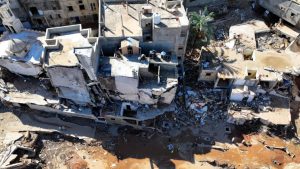These days mark the thirteenth anniversary of the military invasion by (NATO) forces of Libya, Africa’s richest oil nation, which left behind widespread destruction and a shattered country waiting for an opportunity to try to rise.
NATO’s military intervention in Africa’s largest oil state, which began on March 19, 2011, came through a loophole in a Security Council resolution calling for a no-fly zone and measures to protect civilians, as events later revealed that this intervention was prepared in advance of the resolution.
NATO’s bombing of Libya began on March 19, 2011, and continued for seven continuous months, during which the alliance carried out more than 26,000 sorties targeting infrastructure and a large number of state facilities, where the destruction of about 6,000 facilities was documented, in addition to thousands of victims and injuries.
NATO’s intervention, described as “catastrophic” by former Arab League Secretary-General Amr Moussa, left besides destruction a country divided between East and West, and numerous endless conflicts.

The western part of Libya, which stretches from Sabha to the capital Tripoli, suffers from a series of internal conflicts between the internationally recognized Government of National Accord (GNA) and groups vying for control and influence, as well as factions loyal to Field Marshal Khalifa Haftar, the son of the Libyan military establishment.
Political parties in the western part compete with armed factions for power and natural resources, which has played a major role in deepening divisions, in addition to the influence of some areas by religious extremism and the growth of political Islam activities, which led to the escalation of internal tensions, in this resource-rich part that has been looted.

Cities and regions in the western part of Libya are witnessing great activity of armed gangs, as the residents of these areas suffer from insecurity and increased organized crime activity and robberies, as a result of the preoccupation of political parties with the struggle for power and their lack of interest in issues related to civilians within their areas of influence, leaving them vulnerable to security chaos.
Since NATO strikes, infrastructure in these areas has been suffering from destruction that has doubled the burden on the health and education sectors, led to a decline in basic services such as water, electricity, and sanitation, in addition to widespread poverty in many areas and high unemployment.

In contrast, the eastern region of Libya is under the authority of the Benghazi-based interim government and has received the full support of the commander of the Libyan National Army, General Khalifa Haftar, who declared that his goal is to stabilize and help the interim government work to improve the reality of life in the eastern region.
The interest in infrastructure has contributed significantly to economic growth as a result of investments in key sectors such as oil and gas, which has improved the standard of living of citizens.
The interim government has the support of many countries and political actors, including Egypt, the United Arab Emirates and Russia.
The Eastern Government continues its efforts to strengthen international relations and gain international support, seeks to participate in international negotiations to find a political solution to the conflict in Libya, and seeks to strengthen economic cooperation with partner countries to develop infrastructure and promote foreign investments with the aim of improving economic conditions inside the country.
The current scene of Libya, more than a decade after its destruction, paints a picture of a torn country, whose western half is suffering under a set of accumulations left by the war, whether service, security or even living, at a time when its western half is trying to advance the entire country.
The resumption of tourist train trips from Russia to North Korea after years of hiatus
